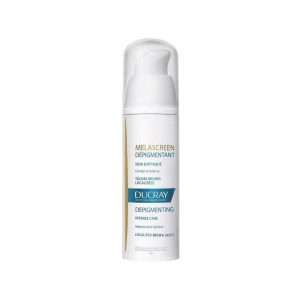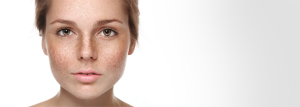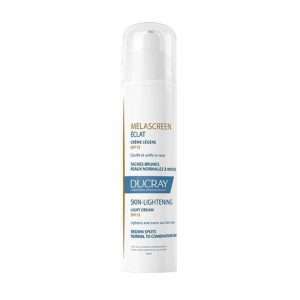
Freckles, age spots, brown spots, chloasma or melasma – whatever you call it, irregular skin discoloration is a distressing problem caused by factors such as sun damage, certain inflammatory skin disorders and hormonal fluctuations. For every woman who suffers from skin pigmentation and has not yet found a solution, this article is for you. It is true that the appearance of pigmentation on the face is not easy, but you can treat it by using specialized treatments for this condition. Keep reading as we will be discussing, in collaboration with the dermatologist Dr. Hussein Yassine, the key steps to reduce skin pigmentation.
What causes and/or triggers skin pigmentation?
First off, what is pigmentation? Pigmentation means coloring. Skin pigmentation disorders can affect the color of your skin. Your skin gets its color from a pigment called melanin, which gives color to our skin, hair, and eyes. Special cells in the skin produce melanin. Once these cells become damaged or unhealthy, it affects melanin production.
Sun damage is the most common cause of skin pigmentation and usually affects the parts that are most frequently exposed to the sun. Other causes include:
- Hormonal changes
- Age
- Skin injuries and inflammation
- Diseases and medications
Are there different types of pigmentation/dark spots?
As discussed, pigmentation refers to changes in the melanin (pigment) of your skin. You should be aware that there are different types of pigmentation and they do not all respond to the same treatments. It goes without saying that a correct diagnosis of the type of pigmentation is essential to guarantee optimal results. Dr. Hussein Yassine indicates that pigmentation varies according to two things: skin type and environmental factors.
There are 4 common types of pigmentation:
1- Freckles
This is the most common type of pigmentation. They appear darker during the sunny months and fade in the winter. Dr. Hussein Yassine explains that people with fair skin are more prone to developing freckles. He also adds that heredity is another factor that could play a role in the appearance of freckles.
2- Lentigines
As you age, you may notice the appearance of brown or black spots on your skin. These spots are especially common on sun-exposed areas like your face and the back of your hands. These spots are caused by the sun’s UV rays and the severity depends on how much UV light the melanin pigments are exposed to.
3- Nevus of ota
Nevus of Ota is a type of dermal melanocytosis (excess of melanocytes in the tissues) that causes hyperpigmentation of an eye and the surrounding area. It often takes the form of bluish or brownish pigment around the eye, along with this pigment appearing on the whites of the eye.
4- Melasma
Melasma or chloasma is a pigmentation that is located deeper in the dermis of the skin. It appears on the face in the form of large brown spots with a non-distinct border. This type of pigmentation is more common in women over the age of 40, says Dr. Hussein Yassine.
Some people are born with pigmented lesions, while others develop them over time. Pigmented skin lesions are usually no cause for concern. In fact, nearly all adults have at least a few of them on their skin. But some can turn into different forms of skin cancer. That’s why it’s important for you and your doctor to monitor them closely.
How can we avoid skin pigmentation?
Sun damage is the number one cause of black pigmentation on skin, and you can definitely prevent sun damage by applying SPF and staying out of direct sunlight.
Although not all causes of pigmentation on face can be prevented, there are steps you can take to prevent some of them:
* Avoid direct sunlight and stay out of the sun during the peak hours of 10 am to 2 pm.
* Shade your face and scalp with a wide-brimmed hat.
* Avoid exposure to the sun without applying sunscreen.
* Limit touching your skin. Scratching or picking a mosquito bite or a spot can cause inflammation and darker pigmentation on your face, so it’s best to avoid touching your skin.
What is the best skin care routine for pigmentation?
To improve the appearance of pigmentation, you need to ensure your routine involves ingredients that are proven to lighten and even out your skin tone.
1- Sunscreen
Dr. Hussein Yassine indicates that the first line of defense, especially for freckles, melasma and lentigos, is to protect your skin. He stresses on the importance of using a sunscreen with an SPF of 50+ and putting on the right amount which is about 2g/cm2.
Sunscreen is vital to prevent existing pigmentation from darkening as well as stopping some types of pigmentation from developing. Reapply it every 2 hours if you’re out in the sun, and more frequently if you’re sweating or swimming. We’d like to share with you our favorite sunscreen to keep you protected from UV rays.
Ducray, the leading brand for skin problems, brings you Melascreen UV Light Cream SPF50+. Its formula is specifically designed to fade away dark spots and protect against photo-aging. It is suitable for normal to combination skin.
Dr. Hussein Yassine adds that people prone to pigmentation should use moisturizers with SPF and put sunscreen on top. Likewise, makeup powder should also contain SPF. This will help protect your skin from UV rays, infrared light and visible light.
2- Chemical peels
A chemical peel is a procedure in which a chemical solution is applied to the face, neck and hands to exfoliate the skin (remove dead skin cells), stimulate the growth of new skin cells and reveal new skin. Dr. Hussein Yassine indicates that depending on the issues you’re addressing, you’ll choose one of three depth peels:
- Superficial chemical peel: used for glow, to unify the skin tone.
- Medium chemical peel: used for a more severe type of pigmentation.
- Deep chemical peel: used to reduce wrinkles and tighten the skin.
3- Topical lightening creams for pigmentation
When it comes to choosing your serums and creams, look out for products containing high percentages of pigmentation-targeting ingredients. Azelaic acid, niacinamide, vitamin C and vitamin A are all fantastic actives to keep an eye out for.
To make it easier for you, we recommend the following products from Ducray, which will help you prevent and fight these spots: Melascreen Depigmenting Intensive Care is a topical treatment rich in depigmenting active ingredients (azelaic acid and glycolic acid) and is proven to effectively reduce localized hyperpigmentation. For optimal efficacy, apply it morning and evening to the affected areas. For best results, use it for 3 months.

4- Laser treatment for pigmentation/IPL
A laser peel (resurfacing) treatment uses targeted beams of light to reduce hyperpigmentation. However, laser treatment for pigmentation has many side effects, including redness, swelling, itching, acne, infections, etc.IPL therapy is a type of fractional laser treatment. It is used for general pigmentation problems, but flat spots especially respond to this treatment. It can also help reduce the appearance of wrinkles, spider veins, and dilated pores.
How can pregnant women deal with pigmentation?
If they already have pigmentation, Dr. Hussein Yassine advises them to use pregnancy-safe creams such as azelaic acid and tranexamic acid, which reduce pigmentation while limiting its increase. They should also put on a mineral sunscreen SPF 50+ because they are more sensitive to pigmentation than others. Sometimes it is necessary to wait until the end of the pregnancy to give more advanced treatments, especially if it is due to hormonal changes or the use of contraceptive pills.











